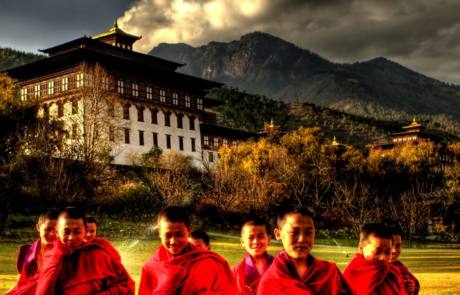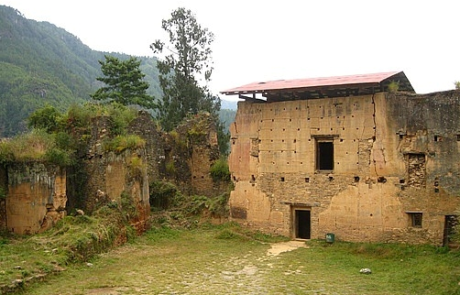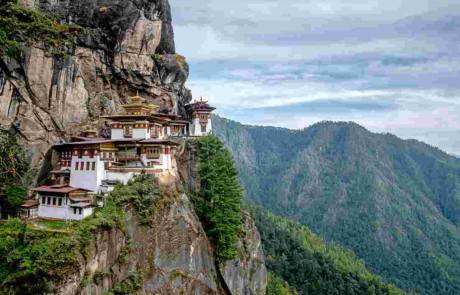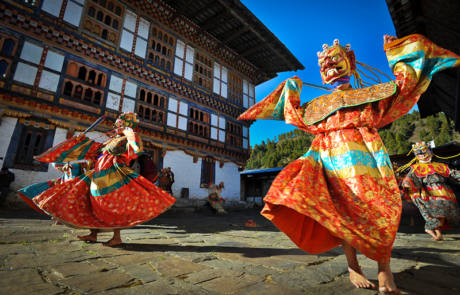10 DAYS/11 NIGHTS
CENTRAL BHUTAN TOUR
Itinerary Summary
With so much to see and experience in Bhutan, how does one choose how long to stay and what to see? We have designed this trip to give you an extra-ordinary experience of life in Bhutan, from the cities and towns to rural life, nature and the stunning landscape and, of course, the monastic life of this Buddhist Kingdom where Gross National Happiness is a higher priority than Gross National Product.
Pre-departure planning is important.
Here are certain things you should watch for and plan for.
Visas
Check with the appropriate consulate or embassy in your country to find out if you will need a visa to visit the country of your destination, especially for an extended period of time. Some countries have extremely detailed and complicated entry/departure laws, and treat visits of a week or two very differently from longer stays.
Money
If you’re traveling to one area, check the cost of living there. If it’s high you’ll probably want to budget more carefully and save some money before leaving. The lower the cost of living the less you’ll have to save, but be sure to have a back up reserve in emergency cases.
General Tips
Talk to other people who have done a similar trip.
If you don’t know anyone personally, try any of the dozens of online travel web sites full of first-person travel stories covering every possible type of trip.
Plan big and loose. Read everything you can about the area.
There may be sights and attractions you didn’t know about. A rough outline of your trip might have three or four target points and a variety of ways to get between them.
You don’t want to find out that the weather isn’t what you thought, or the guide book was incorrect, after committing to 6 weeks in a specific spot.
Some trips will allow you more leeway than others. Travel plans in Asia can often be made day-by-day while summer travel in Europe should be organized at least a few weeks ahead, unless you’re prepared to hunt around for hotel rooms and train seats.
Set up a pre-trip time-line so you don’t end up with a full todo list your last week of work or school.
Things to consider are doctor’s visits for a check up, inoculations, and prescription refills; purchasing plane tickets; renewing passports and obtaining visas and other documents.
Check your insurance coverage abroad and purchasing additional travel insurance if needed. Don’t forget visiting friends and family members!
The longer the trip, the lighter you should pack. This might seem strange, but it’s true you can afford to lug a heavy bag around for a week or two, but do you want to have anything extra for a year?
Stick to the absolute basics and know what you can and cannot buy at your destination(s). There’s no point in bringing 6 months of toothpaste to Europe or buying a sarong at home to take to the tropics. If you are visiting several climates, try to arrange it so you visit the warmer places first and coldest last. That way you can purchase sweaters and long pants and not have to carry them any more than needed. Alternately, visit cold climates first and then ship unneeded layers home — or sell them off.
A good rule of thumb is to bring one outfit for the hottest day you’re likely to encounter, one for an average day, and one for the coldest.
Make sure everything goes with everything else (if that’s important to you), and remember that layers are always best.
Be prepared for uncomfortable trips. You will often find yourself in a busy, cramped, economy class environment and it could be for many hours – especially long plane trips.
If you want to arrive at your destination refreshed and able to enjoy the sights, then try a good quality travel pillow to support your head, some ear plugs to block out the screaming babies, and an eye cover to block out the sun or cabin lights.
Just avoid those cheap U-shaped pillows from airport shops – your head drops forward and you wake up with a stiff neck.
Make contact with the locals before you go.
Maybe you have a friend-of-a-friend or a foreign exchange student from high school you remember, or just found a friend through a travel web site; almost everyone is happy to welcome a foreign visitor to their home town. This might be as elaborate as a home-stay for a few weeks, or just coffee in their home town or dinner at a locals restaurant.
Trip Attractions
Excursion to Taktsang Monastery at Thimphu.
Visit the National Library at Thimphu.
Visit Druk Pungthang Dechen Phodrang (Palace of Great Happiness) at Punakha.
Travel Resources
Travel planning is about more than just knowing where you’re going. Prepares to navigate, take control and be ready for anything. This section helps you steer clear of disaster and stay open to enjoy the unexpected.
Quick Tips
- Banks – Open Monday to Friday 9 am to 2 pm. Some banks are closed for lunch.
- Emergencies – For police, dial a local phone number; for an ambulance call a hospital.
- Internet Access – Wifi is standard in most hotels and free in many coffee shops.
- Mail – Buy stamps at the Post Office. Convenient post offices have located in all cities. Most are open Monday to Friday 9 am to 3 pm.
- Safety – Pickpocketing can be a common problem. It is suggested for men to keep wallets in their front pockets. Purse snatching also occurs at times.
Visitor Information
This site contains information with a very personal and friendly structure. It also has great links to other related sites online.
Information, internet access, maps, and train passes are available at local Tourist Information terminals. These are located at various sites around the city. Expect a wait if you arrive late in the afternoon or during lunchtime. Local travel agencies are also helpful for quick information and finding hotels. There is no service charge for these services. Hours are Monday to Friday 9 am to 5 pm, and Saturday 10 am to 2 pm.
Transportation
Getting in from the airport and other arrival locations. Travel planning is about more than just knowing where you’re going. Prepares to navigate, take control and be ready for anything. This section helps you steer clear of disaster and stay open to enjoy the unexpected.
- Plane – Flights arrive at the main airport near the city center. If flying from European cities, you might land at a connecting airport in Delhi, Kolkata, or Kathmandu. There is a tourist information office at the Terminal E, international arrivals, open 8 am to 6 pm.
- Taxi – From the airport, there is a flat rate for the 1-hour trip, depending on traffic.
- Bus – Buses arrive at the city center. This is the transportation hub for the city and is surrounded by hotels.
A perfect place for exploring on foot, with local shops around every corner. You will eventually walk somewhere, it’s just going to happen. If you don’t like crowds, uneven cobblestones, heavy traffic, or narrow sidewalks, take a taxi or rent a scooter.
Itinerary Details
Day 01: Kolkata
Today on reaching Kolkata Airport you will be met and assisted by our representative and transfer to Hotel. Overnight at Hotel.
Day 02: Kolkata – Paro (Altitude 2280 m) (By Druk Air flight)
Early morning you will be transferred to Airport to board the flight for Paro. On arrival, you will meet our representative and transfer to Hotel. Check-in at Hotel. After lunch, visit Ta Dzong (built-in 1656 and renovated in 1968), an ancient watchtower, which now houses the National Museum. Below the museum is the Rimpung Dzong (literally meaning “Heap of Jewels”), the center of civil and religious authority in this valley, built-in 1646 by Shabdrung Ngawang Namgyal. Dinner and overnight at your Hotel.
Day 03: Paro – Thimphu (Altitude 2320 m, 54 km) Excursion to Taktsang Monastery
After an early breakfast visit to the ruins of the Drukgyal Dzong 16 km up the valley built in 1647 by the great Shabdrung Ngawang Namgyal, father, and unifier of medieval Bhutan, the dzong was destroyed by accidental fire and left in ruins as an evocative reminder of the great victories it was built to commemorate. Explore the ramparts and on a clear day experience an unforgettable view of Mt. Jhomolhari (7,314 m). On the way back, visit Kichu Lhakhang, built-in 659 A.D by the Tibetan king Srongsen Gampo.
- Srongsen Gampo: He was a Tibetan king who married a Chinese princess, Wenchen in 641, as a part of her dowry was a statue called “Jowo” which was an Indian image of Buddha, Sakyamuni as a small boy. In 659, He decided to build 108 Temples in a single day to pin the Ogress to the earth forever and, at the same time, convert the Tibetan people to Buddhism. 6 of these Temples lie in Bhutan, and the most prominent of them are Jambay Lhakhang in Bumthang and Kichu Lhakhang in Paro. Kichu Lhakhang is said to hold the left foot of the Ogress and Jambay Lhakhang pins the left knee.
We drive back the same way to Satsam Chorten, the trail climbs through a beautiful pine forest, many of the trees festooned with Spanish moss, and an occasional grove of fluttering prayer flags. We stop for a rest and lunch at the Taktsang Jakhang (cafeteria) and then walk a short distance until we see, clearly and seemingly within reach, Taktsang monastery. The primary Lhakhang was built around Guru Rimpoche’s meditation cave in 1684 by the Penlop of Paro, Gyaltse Tenzin Rabgay, this incredible monastery clings to the edge of a sheer rock cliff that plunges 900 meters into the valley below. Legend has it that Guru Padmasambhava, the tantric mystic who brought Buddhism to Bhutan in 747 AD, flew here on the back of a flying tiger, Dorji Drolo, said to be his favourite consort. In the evening, drive to Thimphu. On the way, visit Tamchog Monastery built by Thangthong Gyalpo (Popularly known as Lama Chazampa, which literally means, the Iron Bridge builder) in the 15th century.
- Thang Thong Gyalpo (1385 – 1464) was a wonder-working saint from Tibet who came to Bhutan in 1433 looking for Iron Ore. He built 108 bridges across Tibet and Bhutan, out of which 8 were built in Bhutan. His only surviving bridge is in Duksum (Tashi Yangtse in Eastern Bhutan).
Dinner and overnight at Hotel.
Day 04: Thimphu Sightseeing: (Altitude 2320 m).
After breakfast, visit the National Memorial Chorten (1974) built-in honor of our late King Jigme Dorji Wangchuk, and the Dupthop Lhakhang one of the few surviving nunneries in Bhutan. We then visit the National Library, stocked with ancient Buddhist manuscripts, and the Painting School where traditional art is still kept alive through instructions in the art of painting Thangkas (sacred Buddhist religious scrolls).
After lunch, we drive to the Traditional Medicine Institute where medicines are prepared according to ancient practices, and to Lungtenzampa to observe the Royal silver smiths and Bhutanese paper factory at work. Other highlights include a visit to the Tashichho Dzong, the seat of the national government, and the Central Monastic Body, including the summer residence of the Je Khenpo (Chief Abbot of Bhutan). We finally visit the Handicrafts Emporium followed by shopping for souvenirs in the shops of Thimphu. Dinner and overnight in Hotel.
Day 05: Thimphu Sightseeing: (Altitude 2320 m).
After breakfast, visit Folk Heritage Museum, Textile Museum, Changangkha Lhakhang, and Philatelic office.
After lunch, hike to Cheri Monastery and to the Largest statue of Buddha in the world. Dinner and overnight in Hotel Migmar or similar.
Day 06: Thimphu – Punakha: (Altitude 1310 m) (76 Kms, 3 hours drive).
After breakfast, drive to Punakha via Dochula pass. If the weather is clear, we stop for a while at Dochula pass to view Higher Himalayas. On the way, stop a while to view Chimi Lhakhang, which was built by Lama Drukpa Kuenley in the 15th century. He subdued the demons with his “Magical Thunder bolt”. The Temple is also known as “the Temple of Fertility”.
- Lama Drukpa Kuenley (1455 – 1529) was one of Bhutan’s Favourite Saints who was born in Tibet, trained at Ralung Monastery, and was a contemporary and a disciple of Pema Lingpa. He Travelled throughout Bhutan and Tibet as a “Neljorpa” (Yogi) using songs, humor, and outrageous behavior to dramatize his teachings of Salvation through sex.
After lunch, visit Punakha Dzong built in 1637 by Shabdrung Ngawang Namgyal, and is situated between Pho Chu (Male River) and Mo Chu (Female river). For many years until the time of the second king, it served as the seat of the Government. The construction of the Dzong was foretold by Guru Rimpoche, who predicted, “…a person named Namgyal will arrive at a hill that looks like an elephant”. There was a smaller building here called Dzong Chu (Small Dzong) that housed a statue of Buddha. It is said that Shabdrung ordered the architect, Zowe Palep, to sleep in front of the statue, while Palep was sleeping, the Shabdrung took him in his dreams to Zangtopelri and showed him the palace of Guru Rimpoche. From his vision, the architect conceived the design for the new Dzong, which in keeping with the tradition, was never committed to paper. The Dzong was named Druk Pungthang Dechen Phodrang (Palace of Great Happiness). The war materials captured during the battle with Tibetans are preserved here. Punakha is still the winter residence of Je-Khenpo and King Jigme Dorji Wangchuk convened the First National Assembly here in 1952. Dinner and overnight at Hotel.
Day 07. Punakha – Gangtey: (Altitude 3120 m)
After breakfast drive to the beautiful valley of Gangtey. En-route sightseeing in the valley of Wangdiphodrang includes a visit to Wangdiphodrang Dzong(from outside) built-in 1638. Legend relates that as the people were searching for the site of the Dzong, four ravens were seen flying away in four directions. This was considered an auspicious sign, representing the spread of religion to the four points of the compass. The Dzong is situated at the confluence of the Mo Chu and Tang Chu rivers. Drive further to Gangtey.
After lunch visit Gangtey Gompa Monastery, from the outside. Gyaltse Pema Thinley, the grandson and mind reincarnation of Pema Lingpa founded the Temple in 1613, and Tenzin Legpai Dhendup, the second re-incarnation, built the temple. The present Abbot, Kunzang Pema Namgyal is the ninth re-incarnation. It is a Nyingmapa monastery and is affiliated with other Nyingmapa monasteries including Tamshing in Bumthang. Explore Phobjikha valley, famous for the Black Necked Cranes during winter. Dinner and overnight at the Guest House.
Day 08: Gangtey – Trongsa – Bumthang: (Altitude 2800 m, Distance 188 km, Drive Time 6 hour drives.)
After breakfast, drive to Trongsa. Visit Trongsa Dzong, the most impressive dzong of Bhutan, built in its present form in 1644 by Chogyal Minjur Tempa, the official who was sent by Shabdrung to unify eastern Bhutan and enlarged at the end of the 17th century by Desi Tenzin Rabgay. Trongsa Dzong is the ancestral home of the present Royal Family and first two hereditary kings ruled Bhutan from this Dzong. Then Visit Ta Dzong, an ancient watchtower. The chapel inside the Ta Dzong is said to be dedicated to the Trongsa Penlop Jigme Namgyal.
After Lunch, drive to Bumthang. Dinner and overnight at Hotel or similar.
Day 09. Bumthang Sightseeing: (Altitude 2800 m.)
After breakfast, visit Jakar Dzong, which literally means “The Castle of White Bird”. The current structure was built in 1667. Visit Jambay Lhakhang, built by King Srongsen Gampo of Tibet in the year 659 on the same day as Kichu Lhakhang in Paro. The temple was visited by Guru Rimpoche during his visit to Bumthang and was renovated by Sindhu Raja after Guru Rimpoche restored his life force. Under the temple is said to be a lake in which Guru Rimpoche hid several Terma. In October one of the most spectacular festival, “Jambay Lhakhang Drup” is staged here.
After lunch, we visit Kurjey Lhakhang which is named after the body print of Guru Rimpoche, built-in 1652 by Minjur Tempa. Visit Tamshing Lhakhang (Temple of the good message), established in 1501 by Pema Lingpa and is the most important Nyingmapa temple in the kingdom. In the evening, visit Membarstho which literally means, “The burning Lake”. Dinner and overnight at Hotel.
Day 10. Bumthang – Thimphu (212 km): (Altitude 2320 m)
Early breakfast, drive to Thimphu. Lunch will be served on the way. Dinner and overnight in Hotel.
Day 11. Thimpu – Paro – Kolkata – Departure: (Altitude 2280 m)
Early morning, drive to Airport to board the flight for Kolkata. On arrival, you will meet and assisted by our representative and proceed to visit Victoria Memorial, Kali Temple, Howrah Bridge, Jorasanko Palace. Later you will be transferred to International Airport to board the flight for the onward journey.




